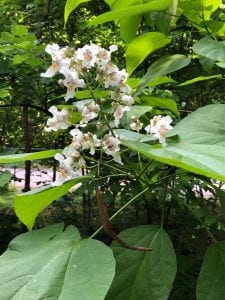Northern Catalpa
(Catapla speciosa [Warder ex Barney] Warder ex Engelm.)
Description
Northern catalpa (family Bignoniaceae¹), a perennial and deciduous tree2, can reach heights of 98 feet and expand to approximately 30 inches or more in circumference with an appearance of peeling, gray bark and cordate (heart-like) leaves of deep green3. It lives approximately 60 years2. The leaves pose in opposite or whorled patterns that can be 7-12 inches in length and 5-8.25 inches in width and are accompanied by white flowers of yellow stripes and purple polka dots amidst the center3. Northern catalpa flowers can reach widths of 2.25 inches and grow in clusters that can reach 7.75 inches3. The fruit of the flower can be long (14 inches) and narrow and can contain more than 100 winged seeds3. Northern catalpa grows at rapid rates in its juvenile stages but slows its growth rate after and after about 20 years.
Flowers of northern catalpa. @ J. Hull 2020 (CC-BY-ND-NC 4.0), Towson University
Northern catalpa leaves, flowers and fruit. @ J. Hull 2020 (CC-BY-ND-NC 4.0) , Towson University
Distribution
Deep, moist, and non-flooded soils with a pH of 5.5 – 7.0 are preferred for ideal growth but the northern catalpa can adjust and adapt to soils of either extreme: wet soils and dry soils2. Northern catalpas tend to congregate upon bottomlands such as the grounds near streams, rivers, or lakes and are generally positioned in wide, open spaces3. The native and non-native distribution differs. Its native distribution is from southern Illinois and Indiana to south to western Tennessee and Arkansas11. Widely planted its current distribution is from New England, to North Dakota; south to Texas, Colorado, Utah and New Mexico; and east to Georgia and north to Pennsylvania. It is not recorded from New Jersey and Delaware.3 It is considered invasive in Maryland12.
 Current distribution of northern catalpa. EDD MapS 5
Current distribution of northern catalpa. EDD MapS 5
Wildlife importance
Northern catalpa is visited by flies, wasps, bees3 and humming birds4 for its flowers. One permanent residential species of the northern catalpa trees is the Catalpa Sphinx Moth4.
Economic importance
Due to its beauty and size, northern catalpa are planted for the purposes of aesthetics and shade and are generally planted along the sides of streets and in residential lawns2. This helps reduce the absorption and reflection of heat by and from the earth and reduce temperatures. The wood has been used for making railroad ties, fence posts beams, furniture and millwork 10,11. Other uses of the northern catalpa are for conservation purposes when land needs restoration after a mining project6. After destructive mining projects are complete, the sites are inhospitable with poor soils, high light conditions, hot conditions7 , however, the northern catalpa can flourish and grow despite the environmental odds.
Threats
Northern catalpa are threatened by Ceratomia catalpa (a sphinx caterpillar) which consume the leaves leading to excess oozing of nectar and vulnerability to predacious insects. Rabbits consume the stem causing girdling. Yellow grub consumes the immature seeds. Cecidomyia catalpae, an invasive insect8 leaves behind leaf spots and damaged terminal buds, branch tips, and seed pods. Macrosporium catalpae, a fungus, creates brown spots; Polystictus versicolor, a decaying fungus. harms the tree after about 20 years of life (more common in the west). Verticillium causes the death of its branches and eventually kill the tree2. Not only can northern catalpa be threatened, but they can also be threatening. Due to their rapid growth rate and pattern, northern catalpa are weedy and, in some cases, invasive, leading to displacement of other desired plant species6.
Interesting facts
- The largest recorded northern catalpa resides in Indiana, USA with a height of 85 feet, expansion of 81 feet, a circumference of 290 inches2.
- Currently, research shows that catalpa trees contain diuretic properties, 2 affecting ability and process of eliminating salt and water from the body9.
- Catalpa seeds can aid in situations of cardiac arrest, spasms, and asthma10.
- The Catalpa Sphinx Moth larvae are great for fish bait, and thus some northern catalpa are intentionally grown by fishers or fishing purposes10.
- A slang name of the northern catalpa is the Cigarette Tree due to the elongation of the fruit of the tree10.
- People who encounter the white flowers can sometimes experience skin irritation due to the chemicals produced by the tree that reside in the flowering cluster7.
References
- Integrated Taxanomic Information System: Catalpa speciosa
- USDA Plants: Catalpa speciosa
- USDA-Forest Service Plant of the Week: Catalpa speciosa
- Arborr Day Foundation: Northern catalpa
- EDD Maps: Northern catalpa
- USDA NCRS Plant Fact Sheet: Northern catalpa
- Missouri Department of Conservation: Northern catalpa
- Discover Life: Catalpa midge
- Yale Nature Walk
- Soft Schools.com: Catalpa facts
- University of Kentucky College of Agriculture, Food and Environment: Northern catalpa
Contributed by E. Jackson and D. Meador


